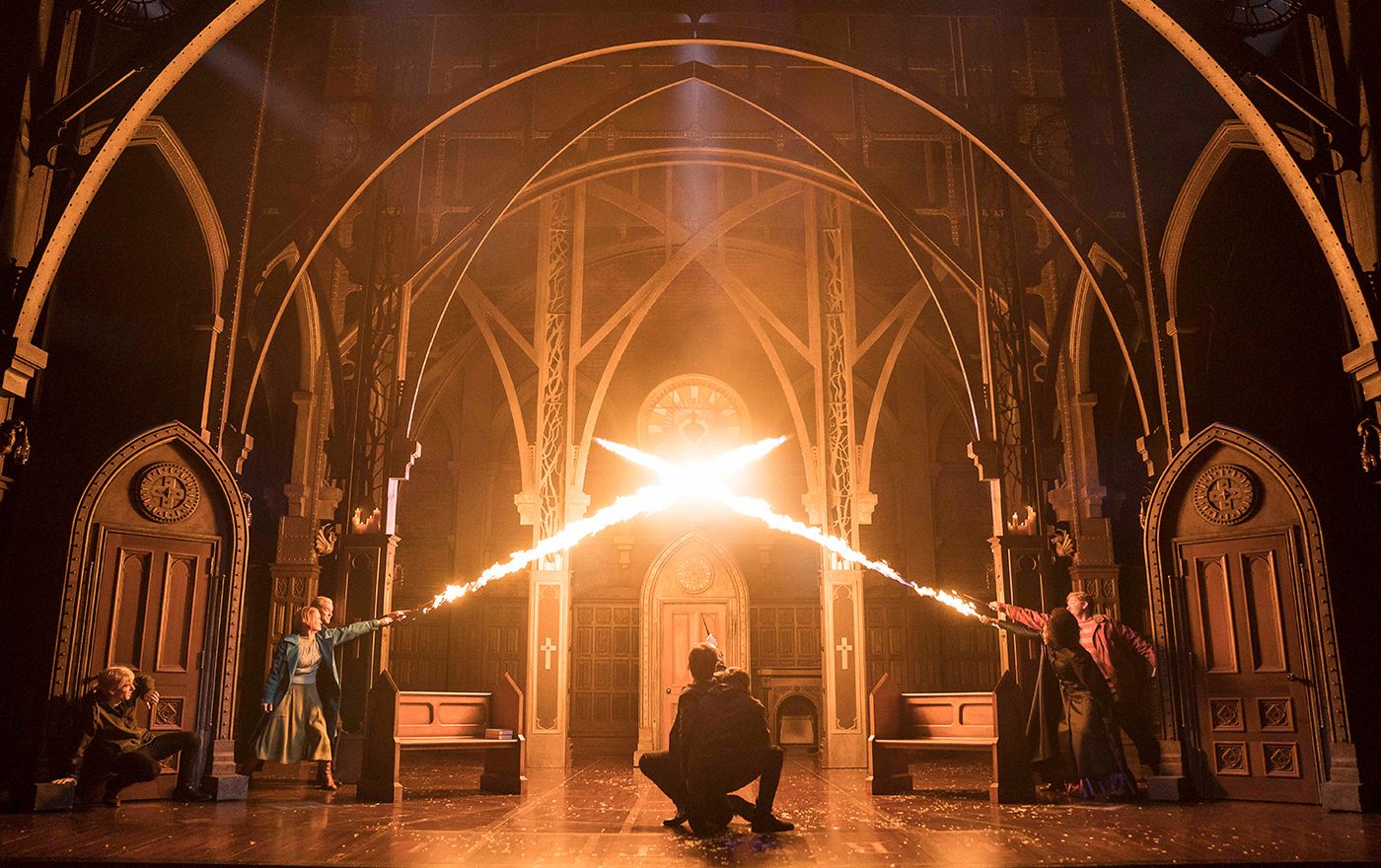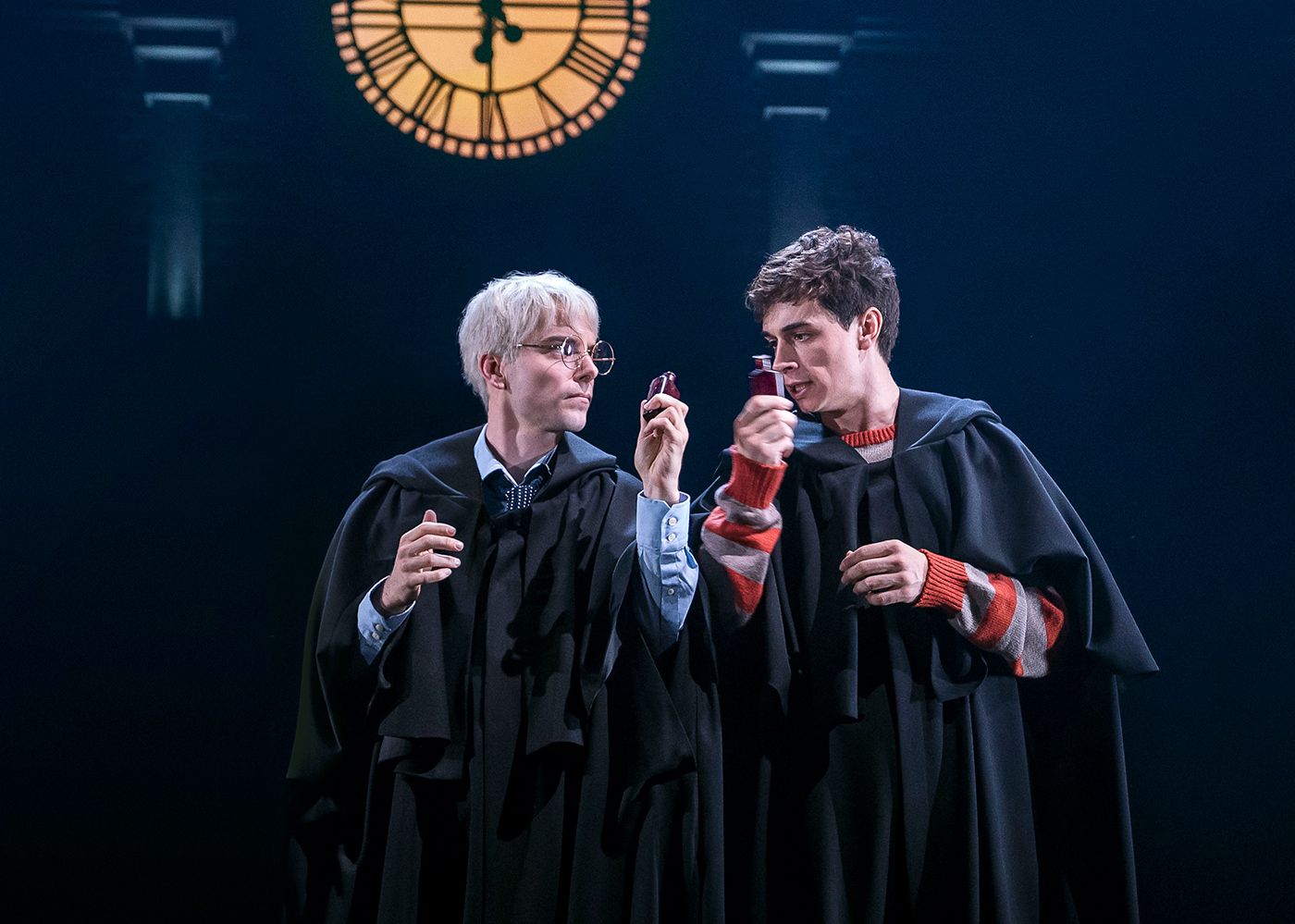Sunday marked the opening day of Harry Potter and the Cursed Child, the epic, Tony Award-winning, two-part play at The Curran in San Francisco. And in its scale and its own fantastical forms of stage wizardry, it's a production that is difficult to compare to anything else in modern theatrical history.
The globally beloved saga of Harry Potter and his friends Hermione, Ron, and Ginny did not end with the seventh novel by J.K. Rowling, Harry Potter and the Deathly Hallows. That book was published in 2007 and turned into a pair of successful films in 2010 and 2011. Just a few years later, with the help of playwright Jack Thorne and British theater director John Tiffany, Rowling co-wrote a continuing, intergenerational saga for the characters set a couple of decades after her wizarding crew graduate from Hogwarts and start sending their own children there.
As was widely written when the show premiered in London over three years ago and then on Broadway in the spring of 2018, the play goes to wild lengths to continue the magic-strewn legacy of the book and film series. It's a veritable showcase of modern stage trickery, lighting design, and a bunch of old-fashioned stagecraft that dates back well into the last century but still holds the power to awe and delight. For every stunning special effect that is only made possible through recent advances in projection mapping or pyrotechnics, there are a half dozen bits of magic and sleight of hand that have been in clever directors' playbooks for decades, but aren't typically deployed one after another, and all in one show.

There is also a surprising amount of dancing and good old-fashioned scene transitions involving ample use of some rolling staircases that serve multiple purposes, though primarily are used to depict the passageways and stairwells of Hogwarts. In these aspects, along with some original music that comes in and out, the show takes on the trappings of musical theater, though without any actual singing.
A few words about the plot, without getting too bogged down or giving away too much: The Cursed Child chapter in this saga does not depart significantly from the universe or the fictional recipes of Rowling's book series. That is to say, fans of the books who know the earlier plot points backwards and forwards and adore the existing cast of characters are in for an extended, nearly six-hour treat in this play, which is essentially a sequel set 19 years after the last book ended. Those who casually watched a few of the films but mostly forget them now will still have a good time, and will likely catch on quickly and remember the major players, but not quite as much as the cooing and tittering Potterheads who will likely be packing the Curran in the show's early run.
Sidebar: Here's a primer with some key details and characters you'll want to probably learn/brush up on.
At Sunday's performances, those fans could barely contain themselves as each familiar character arrived onstage, or as mentions arrived of old scores and legendary fictional Quidditch matches. (I will provide one spoiler, just so hopes don't get too high: There are no actual Quidditch matches played with actors flying on broomsticks overhead.)

The play focuses more on the younger generation, though, in particular the new dynamic duo of Albus Potter (Benjamin Papac), youngest son of Harry Potter and Ginny Potter, and Scorpius Malfoy (Jon Steiger), son of Draco Malfoy. Like his dad, Aunt Hermione, and Uncle Ron, Albus meets his best friend for life in Scorpius aboard the train to Hogwarts headed to start their first year at the school — despite persistent rumors that Scorpius isn't Draco's son but was actually fathered by the long-dead dark lord Voldemort.
There is not a lot of theatrical time spent at Hogwarts, at least in terms of showing kids in their potion and incantation classes, though we do see some glimpses of these. Instead, this is a play that hinges on the moodiness and resentments of young Albus, who rather than doing his dad proud at the school lives unhappily in the shadow of his father's legacy. Harry (played by the terrific John Skelley, who reprises the role after being part of the original Broadway cast) is similarly unsettled in his role as a bureaucrat, now the 40-year-old head of the Department of Magical Law Enforcement at the Ministry of Magic — where Hermione (Yanna McIntosh) is now Minister. Behind on his paperwork, Harry finds himself drawn into a case in which an errant wizard is found to have been hoarding an illegal time-turner — a device used for traveling back in time that the ministry has officially banned, and all of which were thought destroyed. Hermione decides they must keep the device, and keep it secret, just as insurance against the possibility that another time-turner is still out there.

As everyone who watched the Back to the Future series knows well, time travel is an enterprise fraught with unintended consequences for those who wish to return to a familiar future — and you can probably start to see where things may go from here for the Potter crew.
Why does the play take place over nearly six hours spanning two entire parts? Because like its predecessors it is told with a fantasy novelist's grand scope and precision plot-making, with all the occasional tedium, detail, and melodrama that such novels require. That's not to say that the play feels tedious or not genuinely dramatic — much of the drama is gripping, and each intermission as well as the close of Part 1 leave the audience with delicious, gasping cliffhangers. But when the human stories of love, marriage, and the pains and joys of child-rearing are largely just in service of a sprawling fantasy plot, the emotions we're meant to feel for the characters tend to play second fiddle to the emotions evoked by the larger, supra-fictional story arc.
One element that feels important to mention about the new productions is the decision to recast Hermione as a black woman. Fans in London and New York have been somewhat divided — as have fans commenting from afar on Twitter — about the choice, which most of the production team has chosen not to comment on even though every production and cast so far has made the same choice. Many fans of color who grew up loving the books, as well as everyone who wants to see more diversity in such culturally significant franchises, have applauded the choice. Others who have difficulty reimagining Hermione as anything but the white actress who played her may feel some dissonance in the decision, or even call it tokenism as some have — the LA Times addresses the issue in conjunction with the San Francisco opening, and tends to see it as "virtue signaling" by Rowling et al, rather than a truly meaningful choice that has other implications for the play's story.
It's hard to overstate how jaw-dropping some of the special effects are in the show — none of which feel wedged in or unnecessary — and it's no wonder that the play took home six Tony Awards including Best Play last year. Nothing on Broadway has matched it, either for that wizardry or for the play's satisfyingly novelistic sweep. It's a wild amusement park ride, old-timey sideshow, and theatrical event rolled into one. But for old-school lovers of traditional play-craft who don't have time for commercialism and sorcery, it may still be one to sit out.
Harry Potter and the Cursed Child plays through (at least) June 2020 at the Curran. Find tickets here.
Related: What You Need To Know (or Brush Up On) To Best Enjoy 'Harry Potter and the Cursed Child'

